Understanding the Victorian Unfeminine
DOI:
https://doi.org/10.32473/ufjur.v22i0.121838Keywords:
unfeminine, gender studies, Victorian, New Woman, Sensation Fiction, English LiteratureAbstract
My project traces concepts of the unfeminine from Wilkie Collins’s sensation novel The Woman in White (1860) to Victoria Cross’s New Woman fiction in Six Chapters of a Man’s Life (1903). Both texts feature female characters who defy Victorian standards of femininity. Marian Halcombe of The Woman in White is regarded as “ugly,” with “almost a moustache,” yet Walter Hartright (the narrator) admits to the “rare beauty of her form” when he meets her. Marian is also extremely intelligent, using her wits and courage to help protect her half-sister. The unnamed male narrator of “Theodora” from Six Chapters of a Man’s Life meets a similar female character (Theodora), who also has a mustache and looks “like a young fellow of nineteen.” Nonetheless, Theodora is highly educated, even advocating for sex for sex’s sake. Though Theodora is unconventional in her appearance and character, the narrator grows more attracted to her. In defiance of their conventionally unfeminine physical and mental characteristics, both women are regarded as striking by their male narrators. I examine these characters’ unfeminine appearance and heightened intelligence in combination with their radical desirability, suggesting that parallels between Marian and Theodora establish a firm connection between these two Victorian genres as they construct concepts of attraction and the “unfeminine” woman.
Downloads
Published
Issue
Section
License
Some journals stipulate that submitted articles cannot be under consideration for publication or published in another journal. The student-author and mentor have the option of determining which journal the paper will be submitted to first. UF JUR accepts papers that have been published in other journals or might be published in the future. It is the responsibility of the student-author and mentor to determine whether another journal will accept a paper that has been published in UF JUR.

